#metro diaphragm wall
Video
Heritage Infraspace Diaphragm Wall Project for Tokyo Town, Ahmedabad
Another glimpse of success, this time with the Sant Group in Science City, Ahmedabad. We constructed 385.7 meters running Diaphragm Wall with a depth of 12 meters and a width of 600 mm, for 2 levels of basement of this project. Soil Anchoring works will commence post excavation.
#metro diaphragm wall#diaphragm wall#Diaphragm Wall Construction#metro diaphragm wall construction#diaphragm wall contractors#diaphragm wall construction in india#deep basements#deep basement constructions
0 notes
Text
Haikara Walker Pages 179 - 193: The Inconvenient truths of Kamabo Co.
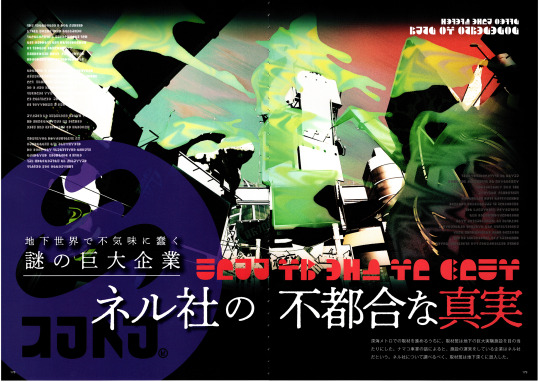
More artbook translations! These ones I translated a couple years ago (except for some stuff on page 188, just did that now lol), but they needed to be spruced up a bit and moved to a more readable format other than shitty discord screenshots on a twitter thread, so here it is. For the most part I’m not gonna bother translating the handwritten text since it’s usually just design notes.
(scans by @milkiemilkshake)
[178 + 179, which is the first image i posted]
A huge, mysterious company that creeps in the underground world
The inconvenient truths of Kamabo Co.
During our coverage of the Deepsea Metro, our reporters saw a huge underground experimental facility. According to the sea cucumber conductor, the company that operates the facility is called Kamabo Corporation. In order to find out more about Kamabo Co., our reporters infiltrated deep underground.
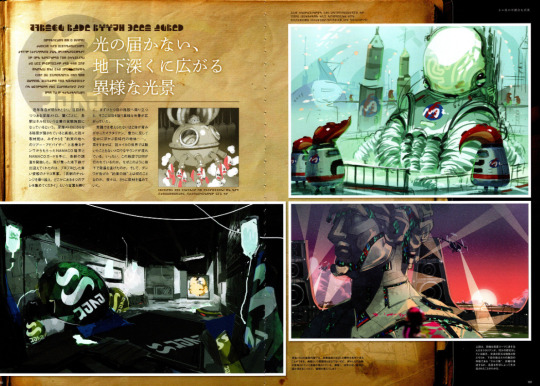
[180 + 181]
Beyond light's reach, unusual sights spread in the deep.
[180] In recent years, the existence of the Deepsea Metro has become clear and has garnered attention. Surprisingly, each station is said to be an experimental facility of a company called Kamabo Corporation. Our reporters had a hunch that more secrets were hidden further in the Deepsea Metro. We received a CQ-80 and a CQ Card from the Telephone, who called itself "The Tour Guide to the Promised Land," and started the investigation. As we hopped on the subway, we were greeted by a squishy and blue sea cucumber conductor. "Overcome the challenges of each station, and gather the four thangs" are the words we went by. As we arrived at the first station, we couldn't believe our eyes at the extraordinary spectacle. There were Octarians whose bodies were so unthinkably blue, and objects from back in the day, floating in the air, defying gravity.... And when we listened closely, we could hear mellow sounds, unlike anything heard in the squid's world. What does this facility do? Why did it develop in this way underground? And what is the "promised land" told by the Telephone? We will continue our coverage further.
[Page 181, bottom left] Inside the facilities of the Deepsea Metro, medical instruments and equipment can be seen everywhere. Although the hospital-esque atmosphere isn't completely there, there are traces of some clinical trials that have been conducted. As the mystery of the dim and lifeless facility deepens, one could shudder at the thought of it....
[Page 181, bottom right] The upper image shows Octarians who are dressed in protective body suits, who appear to be doing some sort of research. What is the huge object in the center? The lower image is of the NILS Statute, which is the center of Kamabo Co.'s facilities. Details will be described later, but it’s understood that it was created through advanced science.

[182 + 183]
Aiming for the "Promised Land": to the core of Kamabo Co. and the NILS Statue
[182 bottom left] While surveying the facilities found along the Deepsea Metro, our reporters found a huge statue called the "NILS Statue." Upon closer examination of it's interior, seven areas could be seen, with names based on the organs of the humans who once thrived, such as the "Coccyx Prison" and the "Villi Control Zone."* This is Kamabo Co.'s most important facility, as it has more blue-green Octarians and advanced equipment than the facilities in the Deepsea Metro. Through unforgiving Octarian assaults and near-death experiences with the traps strung about, we barely escaped through the top of the statue with our lives. The salty sea breeze comfortably caressed our cheeks, and the radiant rays of the sun shone as it set. In the distance, we could see the region of Inkopolis. Is the world we live in the "Promised Land" the Telephone spoke of?
[* translators note: While in the English version it's all just "(name of organ) Phase", the JPN version gives the areas names that are more specific to what actually goes on there. I figured it would make more sense in this context to tell what goes on in those areas.]
[183 with the arrows and 5 little pictures]
The top of the head, which is the final area. There's several devices alongside each other that one can't even imagine what they’re for. There's a gaping hole where the mouth and the right eye are, and there seems to be something in them. Yet the more you look at it, the more beautiful and graceful it looks.
↑
An elevator is installed in the "Spinal central hole". This mechanism that runs through the center of NILS statue is like a spine of a human. From the elevator, you can get to a long and narrow ladder that lets you leave to the surface. It's really long, how many steps are there?....
↑
An energy core is hidden around the "Diaphragm control tower" and "Peristalsis flow passage." When it is set in a certain place, the core supplies a tremendous amount of electricity to the inside the statue. At first glance, the core looks like a Zapfish, but its power is beyond comparison.
↑
The abdomen of NILS statue. This area is fully prepared to keep intruders away, as it is packed with things such as moving scaffolds and life-threatening lasers. Sometimes the Telephone's voice can be heard through the CQ-80, but one can't tell what it's saying, as the transmission gets cut off.
↑
An area located around the waist of NILS Statue. Since weapons can not be found anywhere, one must use stealth to advance. Move slowly, as any sudden movements will expose one's whereabouts to the Octarians.
[183, small text by the cut open statue] An image showing how the internal structure of the human body has been applied to that of the NILS statue. While looking at the statue, we can't help but wonder: are we just something that gets digested through its body? The rumor that the NILS logo represents a "stylish turd"* suddenly has some truth to it.
* [translators note: literally says "kakkoi unko". take that as you will.]
[183 handwritten captions]
[pointing to the top of the statue's head] Mem Cake
[bottom right] Digest everything and knead it well, and it'll turn into one thing→

[184 + 185]
Revealing Kamabo Corporation's Eight Secrets
[184] As a result of searching all over the Deepsea Metro, these eight confidential documents related to Kamabo Co. have been found. These documents show devices that aren't seen in our world, but if their functions and purposes can be explained, then maybe we can reach the hidden truth and essence of the company called Kamabo.
File no. 1
Telephone
[184] A machine installed at the central station. Although it appears to be a piece of telecommunication equipment that was used ancient times, it seems that it was made by combining some of the latest technology. It has the function to detect an ID from an Octarian's body and discern individuals. Removing the back cover confirms it has an elaborate internal structure.
File no. 2
Ticket Examiner
[185 top] Ticket gates and dressers are set up at the entrance of each station of the Deepsea Metro. After getting off the metro and choosing a weapon with the dresser, it appears that there's a system in the ticket gate that opens when the specified amount of CQ Points are paid. When one returns to the dresser after clearing a mission, they can receive a Mem cake.
File no. 3
Goal Point
[185 bottom] The goal point provided at the innermost part of each experimental facility starts up by painting the device with ink, and stops after a certain period of time elapses. It's a device that has been confirmed to be seen even in the Octarian residential areas, but the ones in the Deepsea Metro are shaped like a pen or a push button.
[translators note: The goal point likely looks like a pen because the words for "ballpoint" and "goal point" are extremely close in Japanese.]
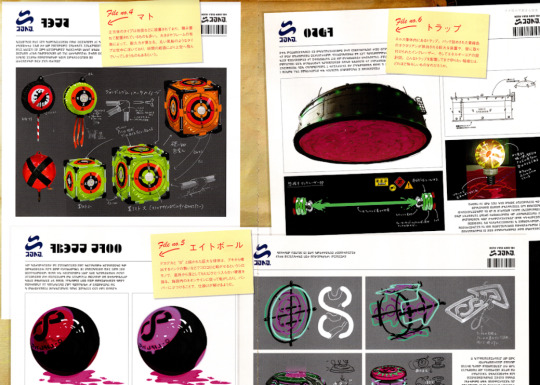
[186 + 187]
File no. 4
Target
[186 top] The kind of targets that looks like a cube can be set up on the ground, or are often arranged in stacks. The durability depends on the size of the frame. The kind that looks like a round balloon floats in the air. They say that after a certain amount of time passes, it soars up into the sky.
File no.5
8-ball
[186 bottom] A huge sphere with a big "8" drawn on it. One can roll it around using the momentum of the ink fired from a weapon for example. It is a fine product that boasts of it's sturdiness; if it falls from a high place, it wont get a single crack. It seems that challenges can be solved by rolling it in accordance with the on-site neon signs, and by hitting the bumpers.
File no.6
Traps
[187] Traps found within the body of the NILS statue. There are blueprints of a large device that ejects blue-green Octarians that have been packed in boxes, a wall-mounted ink laser, and an energy core. How dreadful would a secret have to be for one to guard it with traps?
[handwritten text by the power core]
-On a closer look, it's a nucleus-like part of a baby Zapfish. It actually is an egg.
-The baby is blobby.
-The energy is captured with the socket

[188 + 189]
File no.7
NILS Cannon
[188 top]The NILS statue seems to exemplify the dignity of Kamabo Co. Set in its oral cavity is the NILS Cannon, a device that radiates an enormous amount of energy, said to hold the surprising power to remake the world. When it's triggered, our world may be destined to fall....
[188 bottom, by bottom left image] The top of the NILS Statue's head. There are huge tanks and countless antennas and radars that catch radio waves of some kind, reminiscent of an advanced chemical plant or military facility. Just what was this place made for?
[188 bottom, by image at the bottom of 189] The mouth area of the statue operates like a ventriloquist's dummy, and the NILS cannon is deployed as if it's being spat out. The cannon is filled with bright green ink. Upon closer inspection, there seems to be something mixed in among the ink...?
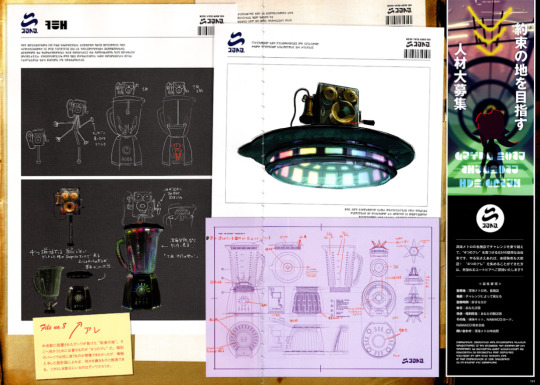
[190+191]
File no. 8
Thangs
[190] It gets installed in the Central Station, and as told by the Telephone, it leads to the "promised land". In order to get there, one needs to collect "the four thangs". One can't even imagine what the individual parts do, but according to these top-secret blueprints, one can guess that it's something that kneads. Is that the Telephone in the part that looks like a lid?
[advertisement on the right side of 191]
Aim for the promised land
Mass Recruitment of capable beings
Overcome challenges at each facility in the Deepsea Metro,
and do the simple job of finding just four "thangs". Even the inexperienced are warmly welcomed, all that matters is if you're motivated! If you can collect the four "thangs”, you will be invited to a bright utopia!!
<Application Requirements>
Working place: In the Deepsea Metro, all facilities
Reward: depends on the challenge
Working time: as much as you like
Holiday: up to you
Remuneration and benefits: depending on your skill
Others: you will be supplied with a sample kit*, CQ Card, and a CQ-80
Contact: Deepsea Metro Central Station
[* translators note: The "sample kit" is the name of the bag attached to your ink tank that expands and explodes when you fail a test. JP splat twitter made a post about it, but the SRL never translated it for some reason.]
333 notes
·
View notes
Text
Take My Breath Away, Part 2
TW: Paralysis
Metro-General Hospital
“I think it’s Guillain-Barre syndrome.”
“Are you sure?” Christine asked in new-found anxiety. "Are you absolutely sure?"
“Of course I’m not,” Stephen said tersely. “I can’t be. But the clinical picture fits. He had the respiratory infection that was going around last week, and the tingling and weakness started today.”
For the hundredth time since he brought Loki in to the emergency room, fully paralysed from the waist down, he cursed himself. “I should have known something was up.”
How could he have missed the signs? The lingering weakness, the unsteady walking, the general malaise that was so out of character for Loki...all of them Stephen had simply put down to a post-viral infection fatigue, instead of something much more serious.
Life-threatening, a voice corrected.
“Don’t beat yourself up, Stephen. It’s not helping.” Ever the voice of reason, Christine was still the grounding force he had once relied on. “Focus on what’s important.”
“It’s progressing way too quickly,” Stephen said worriedly, staring through the observation window into the room where Loki was currently resting.
“He hasn’t consented to assisted ventilation?”
Stephen shook his head, visibly morose. “He hates the idea of being put to sleep.”
“He’s going to tire soon,” Christine warned. “We’re risking respiratory failure.”
“I brought in the big gun.”
Stephen nodded at the tall figure whose silhouette they could see pacing Loki’s room like a caged tiger. “Let’s hope Thor can knock some sense into his brother.”
***************************
“Brother, you are clearly struggling. Why are you giving the doctors a difficult time?”
Loki refused to answer. He was not wasting precious breath explaining his reasoning, unreasonable as it may be, to someone so adamant in his mission to subjugate Loki to the mercy of doctors, human doctors who knew nothing about his kind.
"Loki, we don't have much time."
"There is no 'we' here, Doctor Banner."
Loki turned his head slowly to the other figure in the far corner of the room.
Like a Shadow. Like Death. Just standing there waiting.
“There is no treatment. You said so yourself.” Loki closed his eyes. He did not wish to see Thor's expression. Also, the double vision was worsening. “They can do nothing."
“Human immunoglobulin therapy is incompatible, and we are risking anaphylaxis with artificial plasma exchange,” Bruce repeated the conversation he had with Stephen word for word. "But there's still something we can do to help you tide this over - "
"There is no tiding over anything," Loki said in frustration; if he had the strength, he would have ripped out the oxygen-delivering cannula from his nose. "What you are doing is merely prolonging the inevitable."
"Going on life support is not a death sentence, Loki," Bruce said, his voice hard.
"None of you can tell me with absolute certainty when you can take me off it," Loki rasped. "What was the 'ballpark' figure again? Weeks to month? No."
The outburst cost Loki energy he could not afford, and the harsh sounds of his gasps drowned the noises of the machines.
"Brother!" Stricken, Thor dropped into the chair and grasped Loki's shoulder. "Save your strength."
The wiry cords of muscles of Loki's normally slender neck bulged as the Asgardian struggled to pull air into his starving lungs, and Bruce could not help but stare. Soon, those muscles too, like the respiratory muscles in his thorax and diaphragm, would cease to function.
When one's own immune system attacks one's own nerves, the result is devastating, Stephen had said.
"I'm calling Strange," Bruce said.
“No, you are not,” Loki gasped. “I will not be put down like some kind of animal."
If Loki had seen the devastation in Stephen's eyes the moment Bruce told him they simply did not have enough of Loki's blood sequestered in storage for emergencies such as this, Loki would be singing a different tune.
"Stop being such an idiot," Bruce snapped. "Noone's putting you down, and you are not going to die. Get over yourself and snap out of it!"
Loki's sneer curled into a cruel, ugly smile. "Of course. I had no say in how I lived. How could I expect differently now that I am dying?"
"Loki," Thor growled warningly.
"What will you do, Brother?" Loki asked. "Take Mjolnir to my head? What will you do to force me to submit to you?"
Now that he was calmer, he could breathe easier.
Or perhaps, it was simply a momentary respite, a blessed, temporary relief before…
Before what?
Loki stared at the bright lights over his head and something in him died at the paradox of seeing something so glaring, so full of life, when the rest of his body from the neck down was shutting down.
"I wish to be alone."
***************************
"Any luck?" Stephen asked quietly.
He had pulled some strings and gotten Loki a private room, away from the public eye. It was good thinking on his part, for the expression on Thor and Bruce's faces as they stepped out of the room and into the hallway could only be described as murderous.
"There's no getting through to him," Bruce fumed. The physicist looked furious enough to punch a hole through the hospital wall, and for a precious moment, Stephen felt touched by the sentiment.
"Thank you," he said sincerely. "For trying."
Bruce pulled off his glasses and massaged his eyes. "So what do we do now? Just wait till he passes out and then stick a tube down his throat?"
"Christine would never agree to that."
"Surely you can do it?" Thor asked.
"Physically, sure. Medicolegally? Ethically?" Stephen shook his head. "And I would never do that to Loki."
"Can't you make this immunogoblin thing? The one that you said wasn't compatible?" Thor pleaded.
"IV immunoglobulin's derived from a large pool of plasma collected from thousands of blood donors, Thor," Bruce said glumly. "There's only one of him."
"But we've started saving Loki's blood, have we not?" Thor pressed. "Can't you two work with that?"
"Even if we had the resources to isolate and autotransfuse Loki with his own immunoglobulins, it will not be enough," Stephen said quietly. "And the treatment is only helpful in lessening the severity of the disease."
"You don't mean…" Thor could not bring himself to complete his sentence.
"There is no known cure for Guillain Barre syndrome."
Thor's jaw gave an abrupt click, before his broad shoulders squared a split-second later. "Then I go to Jotunnheim."
Bruce's head whipped up, and together, the two humans stared at the God of Thunder like he had gone mad.
"Quill can take me. We're good friends and he has a strong, sturdy ship." Thor's chest swelled in sheer determination. "We set course for Jotunnheim and I will come back with what you need."
Stephen fought to hold on to the last shred of composure, to keep his voice steady, "Loki will not last the night."
Thor turned as white as a sheet and began to shake.
"For Norns' sake, Man, will you not do something?"
The tears brewing in the stormy blue eyes was all the motivation Stephen needed; with a determined nod, he pushed Loki's door open and stepped inside.
***************************
Stephen watched Loki's chest rise and fall, shallow and laboriously slow.
"I do not fear going to sleep," Loki finally spoke when he could no longer stand the deafening silence.
"Then what is it?" Stephen begged. "What's got you so scared that you won't even try?"
"I fear coming out of it."
"What?"
Loki's lips wobbled. "I heard what your Christine said, about the possibility of permanent damage."
"Loki, we don't know anything about any of that."
But Loki was not listening, so consumed was he by his delusion. "I fear coming back a cripple. A degenerate."
Stephen could only stare at him, stunned.
"I was broken when I came to you," Loki said quietly. "I cannot come back broken. Not again."
"You would rather die for fear of something you think's going to happen? Something unknown?" Stephen asked incredulously, the betrayal blatant in his eyes and bitter on his tongue.
"Then tell me something," Loki said softly. "Tell me that something unknown."
"When we first met..." Stephen's thumb danced across the back of Loki's insensate hand. To think that Loki could not feel him anymore, it hurt him beyond reason.
"You asked me how this was all going to end, for us," Stephen recalled. "Do you remember?"
"What about it?" Loki asked, his voice hollow.
"This is not it," Stephen said, gripping Loki's hand firmly. "This is not how it ends."
Loki's eyes brimmed with tears. "Tell me how."
"I see you and me at the far edge of the world ." Stephen kissed Loki's eyelids, one after the other. "Standing shoulder to shoulder, just us."
"Standing?" Loki echoed breathlessly.
Stephen nodded, and his own tears landed on the bed, darkening it in places. "At the altar too."
Loki let out a sob.
"I love you, Loki." A hand grasped the side of his face tenderly. "Whole, broken, I don't care. I just love you."
"As do I," Loki wept silently. It was getting harder and harder to breathe, what with the invisible weight on his chest. "So very much."
Stephen kissed his mouth fiercely, long, hard and desperate.
"So you gotta do this for me. For us." Stephen's forehead felt hot against his. "Okay?"
"Okay." Loki breathed in as deeply as his constricted chest would allow, committing what he could of Stephen's scent to memory. "Okay."
In a matter of minutes, Loki found himself staring up into a pair of hazel eyes, familiar in their kindness, comforting in their confidence.
"We will take good care of you, Prince Loki," Doctor Christine Palmer smiled reassuringly. "Don't you worry about a thing."
She nodded at someone Loki could not see, and a mask was placed over his face. A sweet-smelling gas began to fill his mouth and Loki coughed weakly.
"Shhh." A hand he knew very well caressed the top of his head. "Sleep, Brother."
Loki's vision blurred. Shadows merged into swaths of colours, of bright blues and greys.
Stephen.
His tears ran freely down the sides of his face but he could no longer feel them.
He was floating, and there was no one there where he was going.
Then he heard a whisper in his ear, "I'll be here when you wake."
There you are, Loki thought, and everything went black.
15 notes
·
View notes
Text
L&T arm bags contracts worth Rs 2,500-5,000 cr for Chennai Metro
L&T arm bags contracts worth Rs 2,500-5,000 cr for Chennai Metro
The construction arm of Larsen & Toubro has secured orders worth Rs 2,500-5,000 crore from its heavy civil infrastructure business in India.
It has secured an order from Chennai Metro Rail Corporation Limited (CMRL) to construct nearly 12 km Twin Bored tunnels from Kellys station to Taramani Road Junction station.
It also involves construction of diaphragm walls of station box and entry and…

View On WordPress
0 notes
Text
Keller and VSL sign £167m HS2 piling contract
The Keller and VSL International joint venture (KVJV) has been awarded a £167m contract to deliver geotechnical work on HS2.
The contract was awarded to KVJV by C1 section main contractor Align – made up of Bouygues, Sir Robert McAlpine and VolkerFitzpatrick.
The section consists of 21.6km of high-speed rail infrastructure between London and the West Midlands including a 3.4km viaduct and twin-bore 16km tunnels under the Chilterns.

KVJV’s scope of work is to construct the piled foundations for the viaducts, grouting works, retaining structures for four ventilation shafts, and ground improvement works for the execution of the tunnel cross passages.
At peak of the production it will require 270 highly skilled people working on site.
KVJV has already completed supplementary site investigations and pile testing.

The teams are currently working on advance works for the south portal of the tunnel that will be the entry point for the tunnel boring machines, and the first diaphragm wall for one of the ventilation shafts.
Jim De Waele, Keller President Europe, said: “The KV joint venture is a continuation of our successful partnership on the Melbourne Metro Project in Australia.
“We’re excited to bring our complimentary geotechnical capabilities, experience and capacity on one of the most demanding and exciting transport projects in Europe.”

Peter Hughes – Managing Director, VSL Systems (UK) Ltd added: “We are looking forward to moving into the main works on this project.
“This award is the culmination of a collaborative approach adopted by HS2, Align, KVJV and other stakeholders, to develop the best possible solution for the project and we are excited to be involved.”


0 notes
Text
Keller and VSL sign £167m HS2 piling contract
The Keller and VSL International joint venture (KVJV) has been awarded a £167m contract to deliver geotechnical work on HS2.
The contract was awarded to KVJV by C1 section main contractor Align – made up of Bouygues, Sir Robert McAlpine and VolkerFitzpatrick.
The section consists of 21.6km of high-speed rail infrastructure between London and the West Midlands including a 3.4km viaduct and twin-bore 16km tunnels under the Chilterns.

KVJV’s scope of work is to construct the piled foundations for the viaducts, grouting works, retaining structures for four ventilation shafts, and ground improvement works for the execution of the tunnel cross passages.
At peak of the production it will require 270 highly skilled people working on site.
KVJV has already completed supplementary site investigations and pile testing.

The teams are currently working on advance works for the south portal of the tunnel that will be the entry point for the tunnel boring machines, and the first diaphragm wall for one of the ventilation shafts.
Jim De Waele, Keller President Europe, said: “The KV joint venture is a continuation of our successful partnership on the Melbourne Metro Project in Australia.
“We’re excited to bring our complimentary geotechnical capabilities, experience and capacity on one of the most demanding and exciting transport projects in Europe.”

Peter Hughes – Managing Director, VSL Systems (UK) Ltd added: “We are looking forward to moving into the main works on this project.
“This award is the culmination of a collaborative approach adopted by HS2, Align, KVJV and other stakeholders, to develop the best possible solution for the project and we are excited to be involved.”


from https://www.constructionenquirer.com/2021/02/18/keller-and-vsl-sign-167m-hs2-piling-contract/
0 notes
Text
Gujarat Metro Rail Recruitment 2020 free 135 CGM , Manager & Other Posts
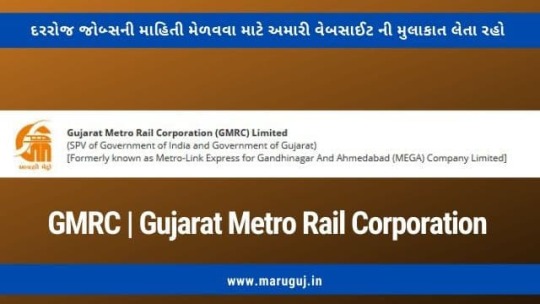
GMRC | Gujarat Metro Rail Corporation Published Latest Job for 135 CGM. Manager and Other Posts 2020. GMRC invites applications from qualified and experienced candidates as per the following posts and appointments will be only on “Contract” with a minimum of 3 years to 5years, on standard terms & conditions of the Organization.
Name of Positions:
1 - Chief General Manager / General Manager (Civil) - 04 Posts
Education Qualification: Candidate must be B.E/ B.Tech (Civil) engineering with a minimum of 60 % marks / equivalent CGPA. Applicants should have minimum 20 years of Post Qualification experience of Executive level in a reputed private organization of Civil Engineering or 17 years Post Qualification experience of Executive level in Government / PSU’s presently working in IDA pay scale of 100000-260000 & above pay scales or equivalent CDA pay scale with experience in the construction of large infra project of planning & execution in Viaducts / Tunnels / Railways / Bridges / Multi‐Stored Buildings / Workshop Sheds.
The candidates will be responsible for supervision and monitoring of Construction works planning, design and interface with Government Agencies, etc. Candidate must be familiar with the management of contracts relating to the large infrastructure projects. Quality Control & Assurance System in civil construction, Safety Implementation, Programme Monitoring, IS /International Codes for construction of civil underground/elevated structures is desirable.
Pay Scale: Rs. 120000‐280000
Age Limit: 55 Years
2 - Additional General Manager (Civil Design / Track) - 03 Posts
Education Qualification:
For Civil Design: Candidate must be a B.E/B.Tech(Civil) engineering graduate from a Govt. recognized University/Institute with a minimum of 60 % marks / equivalent CGPA. Applicants should have minimum 18 years of Post Qualification experience of Executive level in a reputed private organization of Civil Engineering or 15years of Post Qualification experience of Executive level in Government / PSU’s presently working in the IDA pay scale of Rs. 90000-240000 & above pay scales or equivalent CDA payscale with experience in structural design of Metro Viaduct, Pile Foundation, PSC Box Girders, I Girders, Diaphragm walls of Metro Rail Viaduct & Stations and all matters relating to Construction Planning, Construction Progress, Checking/Reviewing Metro Rail alignment, Station locations, land requirement for construction, review of tender technical specifications. Preference will be given to candidates having M.TechinStructural engineering and experience in Bridge/Viaduct/Tunnel designs.
For Track: Candidate must be a B.E/B.Tech(Civil) engineering graduate from a Govt recognized University/Institute with a minimum of 60 % marks / equivalent CGPA. Applicants should have minimum 18 years of Post Qualification experience of Executive level in a reputed private organization of Civil Engineering or 15 years of Post Qualification experience of Executive level in Government / PSU’s presently working in the IDA pay scale of Rs. 90000-240000 & above pay scales or equivalent CDA payscale with experience in detailed track design and construction of Metro Rail / Railway track/track components procurement/planning construction and should be well versed with long welded rail (LWR) design and specifications. Experience should be in Ballast less track. Shall be in charge of all track related works and will also be responsible for track alignment, design & planning and track construction, maintenance and procurement. Candidate should have experience and knowledge of inter‐face with Metro Railway related disciplines such as signaling, traction, and rolling stock, etc...
Pay Scale: Rs. 100000‐260000
Age Limit: 53 Years
3 - Joint General Manager(Civil / Underground) - 10 Posts
Education Qualification: Candidate must be a B.E / B. Tech (Civil) engineering graduate with minimum of 60 % marks / equivalent CGPA. Applicants should have minimum 16 years of Post Qualification experience of Executive level in reputed private organization of Civil Engineering or 14 years Post Qualification experience of Executive level in Government / PSU’s presently working in IDA pay scale of 80000-220000 & above pay scales or equivalent CDA payscale with experience in large infra project execution environment, out of which 5 years’ experience in the construction of Viaducts, Bridges, Multi‐ Stored Buildings, Workshop Sheds.
Pay Scale: Rs. 90000-240000
Age Limit: 50 years
4 - Senior Deputy General Manager (Civil)
Education Qualification: Candidate must be a B.E / B. Tech (Civil) engineering graduate with minimum of 60 % marks / equivalent CGPA. Applicants should have minimum 15 years of Post Qualification experience of Executive level in reputed private organization of Civil Engineering or 13 years Post Qualification experience of Executive level in Government / PSU’s presently working in IDA pay scale of Rs.70000-200000 & above pay scales or equivalent CDA payscale with experience in large infra project execution environment, out of which 5 years’ experience in construction of Viaducts, Bridges, Multi‐ Stored Buildings, Workshop Sheds.
Pay Scale: Rs. 80000‐220000
Age Limit: 48 Years
5 - Deputy General Manager (Civil)
Education Qualification: Candidate must be a B.E / B. Tech (Civil) engineering graduate with minimum of 60 % marks / equivalent CGPA. Applicants should have minimum 10 years of Post Qualification experience of Executive level in reputed private organization of Civil Engineering or 8 years Post Qualification experience of Executive level in Government / PSU’s presently working in IDA pay scale of Rs.60000-180000 & above pay scales or equivalent CDA scale with experience in large infra project execution environment, out of which 4 years’ experience in construction of Viaducts, Bridges, Multi‐Stored Buildings, Workshop Sheds.
Pay Scale: Rs. 70000‐200000
Age Limit: 45 Years
6 - Deputy General Manager (Civil -QA/QC)
Educational Qualification: Candidate must be a B.E / B. Tech (Civil) engineering graduate with minimum of 60 % marks / equivalent CGPA. Applicants should have minimum 10 years of Post Qualification experience of Executive level in reputed private organization of Civil Engineering or 8 years Post Qualification experience of Executive level in Government / PSU’s presently working in IDA pay scale of Rs.60000-180000 & above pay scales or equivalent CDA scale with experience in the field of quality in major infrastructure works e.g. Metro/ Railways/ Airports/ Highways/ Large Industrial or commercial or residential buildings projects.
Pay Scale: Rs. 70000‐200000
Age Limit: 45 Years
7 - Deputy General Manager (Civil -Safety)
Education Qualification: Candidate must be a B.E / B. Tech in Civil Engineering with minimum of 60 % marks / equivalent CGPA with a Diploma/P.G. Diploma in Construction/Industrial Safety.
Pay Scale: Rs. 70000‐200000
Age Limit: 45 Years
8 - Deputy General Manager-Multi Modal Integration(Transport Planning)
Education Qualification: Candidate must be a Bachelor in Planning with minimum 60 % marks/equivalent CGPA & Masters in Transport Planning or related field.
Pay Scale: Rs. 90000-240000
Age Limit: 50 years
9 - Manager (Civil) - 24 Posts
Education Qualification: Candidate must be a B.E / B. Tech (Civil) engineering graduate with minimum of 60 % marks / equivalent CGPA. Applicants should have minimum 9 years of Post Qualification experience of Executive level in reputed private organization of Civil Engineering or 7 years Post Qualification experience of Executive level in Government / PSU’s presently working in IDA pay scale of Rs.50000-160000 & above pay scales or equivalent CDA scale with experience in the areas relating to Construction of Viaducts, bridges, multi storied buildings, workshop sheds.
Pay Scale: Rs. 60000‐180000
Age Limit: 40 years
10 - Manager (Architect)
Education Qualification: Candidate must be a B.Arch engineering graduate with minimum 60 % marks/equivalent CGPA. Applicants should have minimum 9 years of Post Qualification experience of Executive level in reputed private organization of Civil Engineering or 7 years Post Qualification experience of Executive level in Government / PSU’s presently working in IDA pay scale of Rs.50000-160000 & above pay scales or equivalent CDA scale with experience in planning of elevated/ underground Metro stations layouts, Metro Station Designs and checking conformity of station layout to NFPA standards.
Pay Scale: Rs. 60000‐180000
Age Limit: 40 years
11 - Manager –Multi-Modal Integration(Transport Planning)
Education Qualification: Candidate must be a Bachelor in Planning with minimum 60 % marks/equivalent CGPA. Applicants should have minimum 9 years of Post Qualification experience of Executive level in reputed private organization of Civil Engineering or 7 years Post Qualification experience of Executive level in Government / PSU’s presently working in IDA pay scale of Rs.50000-160000 & above pay scales or equivalent CDA scale with experience in Transport sector.
Pay Scale: Rs. 60000‐180000
Age Limit: 40 years
12 - Asst. Manager (Civil)
Education Qualification: Candidate must be a B.E / B. Tech (Civil) engineering graduate with a minimum of 60 % marks / equivalent CGPA. Applicants should have minimum 5 years of Post Qualification experience of Executive level in a reputed private organization of Civil Engineering or 3 years Post Qualification experience of Executive level in Government / PSU’s presently working in payscale of 40000-140000 & above pay scales or equivalent CDA scale with experience in the areas relating to Construction of Viaducts, bridges, multi-storied buildings, workshop sheds.
Pay Scale: Rs. 50000‐160000
Age Limit: 32 years
13 - Asst. Manager (Alignment Expert/CIvil)
Education Qualification: Candidate must be a B.E / B. Tech (Civil) engineering graduate with minimum of 60 % marks / equivalent CGPA. Applicants should have minimum 5 years of Post Qualification experience of Executive level in reputed private organization of Civil Engineering or 3 years Post Qualification experience of Executive level in Government / PSU’s presently working in payscale of 40000-140000 & above pay scales or equivalent CDA scale with experience in preparing drawings of surveyed data on CAD and should have GIS & LIS management skills.
Pay Scale: Rs. 50000‐160000
Age Limit: 32 years
14 - Asst. Manager –Multi-Modal Integration(Transport Planning)
Education Qualification: Candidate must be a Bachelor in Planning with minimum 60 % marks/ equivalent CGPA having minimum 5 years of Post Qualification experience of Executive level in reputed private organization of Civil Engineering or 2 years Post Qualification experience of Executive level in Government / PSU’s presently working in pay scale of 40000-140000 & above pay scales or equivalent CDA scale with experience in Transport sector.
Pay Scale: Rs. 50000‐160000
Age Limit: 32 years
15 - Sr. Engineer (Civil) - 30 Posts
Education Qualification: Candidate must be a B.E / B. Tech (Civil) engineering graduate with a minimum 60% marks/ equivalent CGPA.
Pay Scale: Rs. 35000-110000
Age Limit: 38 years
16 - Surveyor (Civil) - 06 Posts
Education Qualification: Candidate must be a Diploma in Civil Engineering (3 years diploma) with minimum 60 % marks/equivalent CGPA having minimum 3 years of postqualification experience in Survey works of Civil engineering and should have handled all latest equipment’s independently and carried out survey works in large infrastructure projects.
Pay Scale: Rs. 35000-110000
Age Limit: 38 years
1 - General Manager - 08 Posts
Education Qualification: Candidate must be a B.E / B. Tech (Electrical/ Electrical & Electronics) engineering graduate having minimum 20 years of Post Qualification experience in reputed private organization or 17 years in Government / PSU’s of PayScale 100000-260000 and above pay-scales with experience in planning, preparation of technical specification, administration of contracts, installation, testing, commissioning and statutory approvals of electric rolling stock system in railways/metros/ other PSUs/ private sector.
Pay Scale: Rs. 120000‐280000
Age Limit: 55 years
2 - Additional General Manager - 04 Posts
Education Qualification: Candidate must be a B.E / B. Tech (Electrical/ Electrical & Electronics) engineering graduate having minimum 18 years of experience in planning, administration of contracts, installation, testing, commissioning of modern electric rolling stock of railways/metros/ other PSUs/ private sector dealing with Rolling Stock Systems.
Pay Scale: Rs. 100000‐260000
Age Limit: 53 years
3 - Joint General Manager - 04 Posts
Education Qualification: Candidate must be a B.E / B. Tech (Electronics & Communication) engineering graduate having minimum 16 years of post-qualification experience in specifications, installation, Testing & Commissioning of Signaling System works in Railway Systems / METRO / LRT / Sub-urban Rail.
Pay Scale: Rs. 90000-240000
Age Limit: 50 years
4 - Senior Deputy General Manager - 04 Posts
Education Qualification: Candidate must be a B.E / B. Tech (Electrical/ Electrical & Electronics/ Mechanical) engineering graduate having minimum 15 years of experience in planning, preparation of technical specification, administration of contracts, installation, testing, commissioning and statutory approvals of electric rolling stock of railways/metros/ other PSUs/ private sector dealing with Rolling Stock Systems.
Pay Scale: Rs. 80000‐220000
Age Limit: 48 years
5 - Deputy General Manager - 10 Posts
Education Qualification: Candidate must be a B.E / B. Tech (Electrical/ Electrical & Electronics/ Mechanical) engineering graduate having minimum 10 years of experience in planning, administration of contracts, installation, testing, commissioning of electric rolling stock of railways / metros/ other PSUs/ private sector dealing with Rolling Stock Systems.
Pay Scale: Rs. 70000‐200000
Age Limit: 45 years
6 - Manager - 08 Posts
Education Qualification: Candidate must be a B.E / B. Tech (Electrical/ Electrical & Electronics/ Mechanical) engineering graduate having minimum 9 years of experience in planning, design, installation, testing, commissioning of electric rolling stock of railways/metros/ other PSUs/ private sector dealing with Rolling Stock Systems.
Pay Scale: Rs. 60000‐180000
Age Limit: 40 years
7 - Assistant Manager - 20 Posts
Education Qualification: Candidate must be a B.E / B. Tech (Electrical/ Electrical & Electronics/ Mechanical) engineering graduate having minimum 5 years of experience in planning, installation, testing, commissioning of electric rolling stock in railways / metros/ other PSUs/ private sector dealing with Rolling Stock Systems.
Pay Scale: Rs. 50000‐160000
Age Limit: 32 years
How To Apply:
Applicants should fill up the required information online only on our Company website through the link under http://www.gujaratmetrorail.com/careers/ “APPLY ONLINE” along with necessary attachments in a merged single PDF file containing CV, payslips & testimonials, etc., on or before 3rd April 2020.
Any candidate found guilty of impersonation or submitting fabricated documents or making statements, which are false, incorrect or indulging in suppression of facts, attempts to use unfair means for the purpose of recruitment, will be liable for rejection
The candidate shall have to indicate his/her acceptance to the offer within three working days from the receipt of an offer, if not; the next candidate in order of merit will be offered the appointment on similar lines. However, the Competent Authority may grant such extension of time depending upon the exigencies, if so requested.
Last Date: 24-04-2020
Advertisement
View
Corrigendum - Last Date Extended
View Notification
Apply
Apply Now
Read the full article
0 notes
Photo
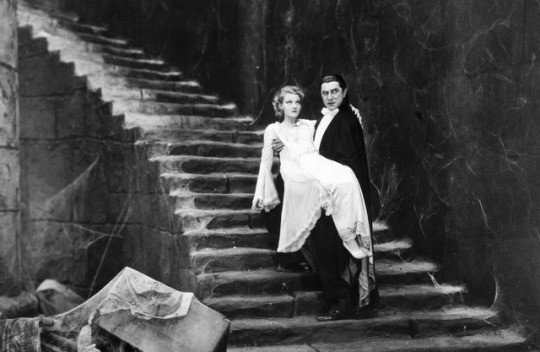
Movie Odyssey Retrospective
Dracula (1931 English-language version)
The 1920s had been an ideal breeding ground for horror films in the West. As cinematic technology improved and daring directors unleashed their magic on nitrate film, audiences found themselves terrorized by titles like Nosferatu (1922, Germany), The Phantom of the Opera (1925), and The Unknown (1927). With the introduction of synchronized sound, it was only a matter of time before someone took the genre to the talkies. Tod Browning (frequent collaborator with Lon Chaney, Sr., including The Unknown) would be that director, and the first horror masterpiece after the silent era would be Dracula, based on the 1924 stage play Dracula (itself based on the classic Bram Stoker novel of the same name). Universal Studios – a major studio but not yet considered in the same class of Metro-Goldwyn-Mayer, Paramount, 20th Century Fox, and Warner Bros. at that time – had been considered specialists in horror and further burnished that reputation here. Hungarian-American Béla Lugosi became an overnight sensation, and since 1931 he has always been associated with black flowing capes, a badass accent, and blood-sucking.
Before a brief synopsis, it should be noted that there is a Spanish-language version of this film, Drácula, directed by George Melford and starring Carlos Villarías as the title character. That film, also released by Universal, came at a time when – during the early years of synchronized sound movies – studios frequently released non-English language versions of their movies (almost always European languages like French, German, Hungarian, Italian, Swedish; a burgeoning, but bankruptcy-prone market for films catering to the United States’ numerous ethnicities existed, too). Thought lost to time, Drácula resurfaced in the 1970s and has been restored for public consumption. A third version – a silent film – was released to theaters that had not updated their technology yet. As should be obvious, this write-up on Dracula will be on the English-language version with synchronized sound.
On Walpurgis Night somewhere in the Carpathian Mountains of Transylvania (present-day Romania), Englishman Renfield (Dwight Frye) is traveling by carriage to reach his client, Count Dracula’s (Lugosi) estate. Count Dracula has expressed his interest in an abbey outside of London. Villagers, warning of the spirit of Nosferatu, are fearful that the Count is a vampire, but Renfield dismisses those concerns. Renfield arrives at the castle, stunned at the immensity of the place and the appearance of a cloaked, slick-haired figure gracefully, slowly making his way down an immense, cobwebbed staircase. After bidding Renfield welcome, something can be heard howling outside.
“Listen to them. Children of the night. What music they make.”
Renfield becomes Dracula’s first victim and servant – groveling, maniacal, and violent – as the plot shifts to England and characters like Professor Van Helsing (Edward Van Sloan), sanitarium Dr. Seward (Herbert Bunston), his daughter Mina (Helen Chandler), Mina’s fiancée John Harker (David Manners), and Mina’s friend Lucy Weston (Frances Dade) begin investigating their newest acquaintance.
As the vampire Count Orlok in Nosferatu (itself an unauthorized version of Dracula), Max Schreck relied on his physical acting and makeup to frighten audiences. As Count Dracula in this film, Lugosi has a powerful weapon not afforded to Schreck: the sound of his voice. Born in 1882, Lugosi, having appeared in 1927 as Count Dracula in the stage play this movie is based on, arrived in the United States from Hungary in 1920. In that interim, Lugosi became fluent in English (this is disputed, but even if he had to learn his lines phonetically, the results were worth it) yet retained a thick Hungarian accent that prevented him from having a more prolific, diverse movie career. Nevertheless, in Dracula, his dialogue delivery – deliberate, deceptive, sometimes pausing for no apparent reason near the end of sentences – is incredible. Where Schreck’s Orlok angled for removing any semblance of humanity, Lugosi’s Dracula (which, on the basis of subsequent cultural references, has become the preferred prototype on which to create a vampiric character) is sophisticated, in touch with his humanity, all while retaining a threatening sexuality – “I never drink… wine,” he says. To put that in terms of a scenario, meeting Lugosi’s Dracula for dinner in any place outside of his castle might leave you charmed by the Count and just comfortable enough to eat and drink in his presence. That is, until Dracula feeds on you.
Universal did not see Lugosi as their first-choice Dracula; instead, that went to the senior Lon Chaney (1924′s He Who Gets Slapped, The Phantom of the Opera). Chaney died prior to production and, despite Universal’s preference for Paul Muni, relented when Lugosi lobbied relentlessly and said he was willing to accept an exiguous salary of $3,500 (~$56,000 in 2017′s USD). Lugosi declared bankruptcy the year after the film’s release. Having turned down the title role in Frankenstein (1931), Lugosi plodded through years of typecasting as suave horror villains and a British ban on horror films in the mid-1930s. He never became as established a movie star as fellow Universal Monsters star Boris Karloff, and played Count Dracula only twice – the second time in Abbott and Costello Meet Frankenstein (1948).
Alongside a bevy of forgettable performers, only one other actor stands out. That is Dwight Frye (who would also play Fritz in Frankenstein later that year) as the realtor-turned-slave Renfield. His performance, nowadays, might be dismissed as a relic of the worst of silent-era filmmaking that seems anachronistic even in 1931, but it works. Whether Frye swings into entertaining campiness or unmitigated insanity, he serves the film wonderfully. With eyes wide, veins pulsing from his neck, and not giving a shit about what people think of his behavior, Frye’s Renfield is unpredictable, unstable, and possesses an unsettling laugh – it is not the stereotypical villainous belly/diaphragm laugh – halfway between a sneer and a chuckle. It is not exactly something you want to hear in the darkness.
Director Tod Browning – an expert in horror films – assembles a team of craftspersons of envying pedigree. Production designers Herman Rosse and John Hoffman and art director Charles D. Hall (1930′s All Quiet on the Western Front, Frankenstein) outdo themselves with Dracula’s castle. It is everything you want from a decrepit fortress – cobwebs (one eighteen-foot spiderweb was created by rubber cement shot out of a rotary machine gun), an enormous fireplace (one fire made so much noise that the primitive microphones then being used picked up that sound rather than the dialogue; production halted as the fire winded down) ruined windows and columns, and tangled vines intruding from the outside. The enormity of the set lands with chilling impact, assisted with the costume design by Ed Ware and Vera West and cinematography by Karl Freund (1927′s Metropolis, 1937′s The Good Earth, I Love Lucy) inspired by German expressionism – a silent film-era movement which emphasized exaggerated geometries, shadows, and high-contrast lights and darks. Freund’s camera is often static but, unlike many films the early 1930s, slowly floats across the set when needed. This creates an impending sense of terror, lending Dracula a thick atmosphere that has kept it watchable even though the movie itself may no longer be scary to most. However, this focus on the production design is mostly abandoned after twenty-five minutes as Dracula finds himself in London. Lugosi and Frye’s performances grab the film by the scruff, and further solidified themselves into Hollywood lore.
The sets themselves impressed Universal’s art department and directorial contractees so much that they remained standing for at least a decade longer for subsequent films for the studio; the finale of Sherlock Holmes and the Voice of Terror (1942) holding its finale within what used to be Dracula’s walls, for example. These same sets also appeared in the Spanish-language Drácula –when the English-language production completed its shooting during the daytime, the Spanish-language production commenced at night using much of the same resources. The cast and crew of the Spanish-language production might even have had an advantage, as they had access to the English-language Dracula’s dailies/rushes (raw, unedited footage of the day’s shooting on a movie), to tinker with their own performances and handiwork.
Other than Tchaikovsky’s most famous theme from his ballet Swan Lake playing over the opening credits and a brief snippet of Wagner and Schubert, there is zero music in Dracula. In scenes as Dracula is approaching someone with ill intentions, this increases the dread. In transition scenes where the audience is reading the text of some publication or when characters are traveling, this might not work with impatient viewers. This almost-complete lack of music is because – with synchronized sound introduced just four years earlier – filmmakers believed that movie audiences could not accept music in a film unless there was a source of music within the film (diegetic music; one of those instances is when an orchestral performance is featured in Dracula). Considering that silent films were never truly silent – movie theaters during the time had resident musicians (typically pianists, organists, or small ensembles) – and that movie music has become a genre all its own, that idea might seem quaint to modern audiences. Watch enough post-Jazz Singer 1920s and early 1930s movies and one will notice that lack of music is widespread.
In other aural developments, depending on the quality of the print that you watch, a crackling image noise may be heard throughout the film. That is due to the age of the film print and the quality of the sound recording available in 1931; the newest restorations of Dracula should minimize the sound.
Though a relic of early Hollywood horror, it is a film energized by a star-making performance from Lugosi, which has since altered audience conceptions of what a vampire looks like, talks like, moves like. Okay, we never see Dracula’s blood-sucking fangs, but credit Lugosi, Browning, and screenwriter Garrett Fort for devising a character that is essentially the origin of anything that even references vampirism.
Dracula shows its age as it approaches its ninetieth anniversary. Wooden acting from almost all of the supporting cast, its rough editing, and pacing issues may not be accommodating for those accustomed to older movies and are watching the film without knowing the limits of cinematic technology in 1931 (again, Dracula may have terrified viewers upon release, but it is no longer “scary” in the modern sense). It is an essential piece of the horror genre, as well as cinema. The dedication to which those behind the camera applied to this film is remarkable, diffusing a frightful feeling that could only have been produced in its own time.
My rating: 9/10
^ Based on my personal imdb rating. My interpretation of that ratings system can be found here.
This is the tenth Movie Odyssey Retrospective. Movie Odyssey Retrospectives are write-ups on films I had seen in their entirety before this blog’s creation or films I failed to give a full-length write-up to following the blog’s creation. Previous Retrospectives include A Boy Named Charlie Brown (1969), Harry Potter and the Sorcerer’s Stone (2001), and The Wizard of Oz (1939).
#Dracula#Tod Browning#Bela Lugosi#Helen Chandler#David Manners#Dwight Frye#Edward Van Sloan#Herbert Bunston#Frances Dade#Carla Laemmle#Garrett Fort#Karl Freund#Charles D. Hall#Herman Rosse#John Hoffman#Ed Ware#Vera West#TCM#My Movie Odyssey
1 note
·
View note
Link
The Noida Authority, which had issued a tender for the construction of the underpass along MP Road 3 November last year but was put on hold, has now decided to begin the work at Sector 52/71 once the election results are declared.
Talking to City Spidey on this subject, an official of the Noida Authority said, “It will be a huge relief to the commuters travelling through Sector 51, 52, 71, 72 towards City Centre, Mamura and Sector 62. Moreover, it will give huge respite to all from traffic jams caused due to passengers commuting via Blue Line extension and Aqua Line metro.”
However, residents living in different sectors across the area have expressed mixed views regarding this development which will take place in a month's time.
Hemant Tyagi, a resident of Gardenia Gateway (Sector 75) said, “Once this underpass is ready, I can go straight to my office and come back home, without taking any diversions. At present, it takes me 45 minutes to reach office from home but once the underpass gets open for public, it will reduce to 20 minutes.”
“The big question is when will the work related to underpass get over? Noida Authority has a record of not meeting the deadline to complete a particular project. As a result, people suffer!” said Akansha Srivastava, a resident of Sector 52.
Talking about the work, the officials of the authority said the underpass would have two lanes on either side. The contractor will make sure the underpass has proper diaphragm walls, arrangements for drainage. Besides, there will a sump for collecting water other than pump house.
“Illegal structures, hoardings, and posters along the stretch will also be removed before the construction begins,” officials of the authority concluded.
0 notes
Link
Encardio Rite was awarded the I&M sub-contract for complete monitoring and surveying solutions for diaphragm walls, ground anchors, piles, groundwater, adjacent ground and buildings, falling within the zone of influence of Msheireb Station and its west entrance structure.
0 notes
Link
Here, the basement floors are made as the excavation progresses where concrete slabs work as lateral stimulating for the perimeter wall system. While ground level and basement slabs are poured, getting hold holes to allow excavation beneath and as every subgrade level is finished; the floors became lateral bracing for the perimeter wall system.
The Perimeter wall is generally known as Diaphragm wall or D Wall, is a single, safe method for all the constructional problems faced in underground construction and these walls give effective earth detention and good control over ground water movement.
These walls are capable to carry the superstructure loads and provide early utilization of the superstructure before the completion of substructure of any building. Basically it is used for deep digging projects where tieback installation is not possible and soil movements need to be decreased like construction of metro station, tunnel, underground etc.
Process of Construction:
1. This Top down construction can construct the perimeter wall, Constructpiles. Also keep the steel columns or stanchions in the construction of piles.
2. It casts the floor slab of the first basement level.
3. Work on the first step of excavation.
4. Start construction of the superstructure.
5. Next cast the floor slab of the second basement level Proceed to the second stage of excavation.
6. Again does the same process till the desired depth is reached.
7. Then construct the foundation slab and many more to complete the basement.
8. Keep constructing the superstructure till it finished.
Advantages:
• This method reduces the time for construction.
• Concrete D walls are most cost-effective in any stage of construction.
• Easier and economical construction of roof.
• The structural slab acts as an internal bracing to reduce the number of required tiebacks.
• Vibration-free operation reduces the potential for ground movement.
• Needs less width for construction area.
Disadvantages:
• Unable to install external waterproofing outside the walls.
• Potential water leakage at the joints.
• More complicated connections for roofs, floor and base slabs.
• There is limited access to excavation and limited space for the construction of base slab.
• Complex design involved.
0 notes
Text
D-Wall for Metro under Construction in India
Underneath a metro under construction in India lies a concrete diaphragm wall providing lateral support so that no accidents occur in future. Heritage Infraspace provides geotechnical solutions combined with modern machinery, excellent engineering and advanced piling techniques for elevated metro construction in India. HIPL also conduct soil tests and uses its own Ready Mixed Concrete to ensure premium quality.
2 notes
·
View notes
Text
Diaphragm Wall for Metro rail construction in India
Heritage Infraspace Pvt. Ltd takes great pride in having contributed to the metro rail construction in India with our diaphragm wall technology, piling and shoring services. HIPL has provided intelligent ground engineering solutions for various metro rail construction in India and have executed them with excellence in collaboration with multiple government departments and some of the top construction companies in India.
3 notes
·
View notes
Text
HIPL X Knowledge Studio – Summer Training program on Diaphragm Retaining Walls
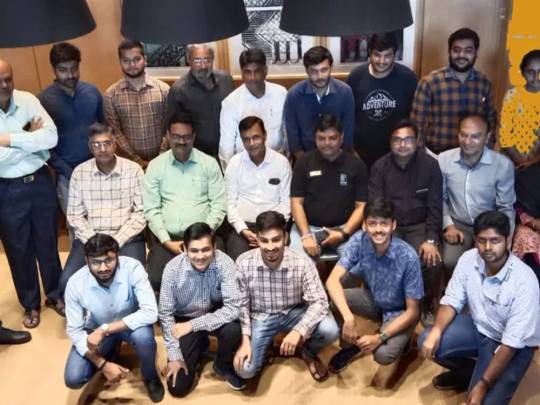
All tall and lasting structures around the world have one thing in common, and that is a “strong base”. Heritage Infraspace Private Ltd (HIPL), as the pioneer of ground engineering solutions and having worked with leading metro construction companies in India, believes so more than anything. Especially when it comes to constructing a sturdy, durable diaphragm retaining wall, and building a strong foundation for young engineering minds.
One such instance was the Summer Training Program 2022 on Diaphragm Walls in partnership with Knowledge Studio in Ahmedabad. Knowledge studio hosted civil engineering students, industry professionals and construction entrepreneurs cum developers for 3 days of interactive sessions with HIPL’s engineers about Diaphragm wall construction and the various nuances of deep basement anchoring projects.
Read ahead to know all about this HIPL Summer Training Program 2022.
The Program Brief: A tale of sharing excellence and experience
Knowledge Studio by Neha Consultants in Ahmedabad joined hands with HIPL to hold a one-of-a-kind workshop aimed at bridging the knowledge and experience gap between students and the industry.
It was an open session held on 20th June 2022 and covered various segments of diaphragm wall construction in detail.
The program would also help popularise the field of diaphragm wall construction for deep basements in civil engineering and building construction companies.
The event was held from 20th to 22nd June 2022, which included 1 day of classroom sessions, and 2 days of active site visits with experts.
Mr. Pranil Chakraborty, the General Manager of HIPL conducted the sessions on Day 1, and discussed topics like diaphragm retaining wall, anchoring, the process, the importance of soil testing, and top-down construction.
50 people signed up for this 3 days training program which majorly consisted of civil engineering students from universities in Ahmedabad.
The audience consisted of industry professionals and associates from various building construction companies wanting to learn about the subject matter of ground engineering solutions for deep foundation projects.
For the remaining two days, team HIPL took the participants for on-site practical sessions about diaphragm wall construction and multi-basement anchoring respectively.

Mr Imran Mondal and Mr Gaurav Patel from HIPL educated the students about the practical implications of diaphragm walls, the equipment and machinery involved, and the whole construction process.
On the third day, Mr Neel Shah familiarised the attendees with multi-level anchoring for deep basement projects.
As a trusted diaphragm wall construction partner to major metro construction companies in India, HIPL keeps to the standard of safety on every project. The same was extended when students and other attendees visited HIPL’s construction site.
The Partners for the Training Program on Diaphragm Retaining Walls:
This summer program was a collaborative effort of Knowledge Studio by Neha Consultants and HIPL.
Neha Consultants is an architectural and real estate construction consultancy based out of Ahmedabad, founded by Mr. Nitesh Shah.
They have consulted and assisted major real estate developers all over the country, and have completed over 2000 projects in the past 3 decades.
Knowledge Studio by Neha Consultants is an initiative to provide students and interested individuals with an opportunity to learn and interact with industry experts, gain practical insights and expand the horizon of learning.
Continue reading
3 notes
·
View notes
Text
The Top Construction Company in India Building D-Walls
Right from metro rail construction to new age superstructures like towering residential and commercial complexes, the building of concrete diaphragm walls has become a common practice and projects are now seeking only the top construction company in India, like Heritage Infraspace Private Limited, to build these D-Walls. This is a civil engineering technique of construction, pioneered by HIPL in India.
#top construction company#construction company#construction#india#Heritage Infraspace Private Limited#D-Walls#concrete diaphragm walls
6 notes
·
View notes
Text
Get the Pioneers to Build Diaphragm Retaining Walls for Your Projects
Every time there is a major underground construction project being undertaken, like building dams, tunnel approaches, deep basements or metro stations, it is important to plan to construct running diaphragm retaining walls first. Heritage Infraspace Private Limited (HIPL) is a pioneer in building diaphragm walls for deep basement constructions like underground metro stations, multi-level basements for residential and commercial complexes etc. Know more about our projects or to collaborate with us on your upcoming projects, get in touch with us today. Drop us a mail on [email protected].
2 notes
·
View notes